from ISSA News feed for the Cleaning Industry https://www.issa.com/news/news-details/all/kimberly-clark-to-upgrade-pennsylvania-facility/
Mold Remediation Baltimore
 The International Facility Management Association (IFMA) has announced details for its 2019 World Workplace Europe Conference and Expo. Next year’s edition will take place March 20-22,... Read more
The International Facility Management Association (IFMA) has announced details for its 2019 World Workplace Europe Conference and Expo. Next year’s edition will take place March 20-22,... Read more Stay up to date on the industry's newest products and services from these ISSA members. A Scent-sational Screen The special formulation in the Vectair Systems,... Read more
Stay up to date on the industry's newest products and services from these ISSA members. A Scent-sational Screen The special formulation in the Vectair Systems,... Read more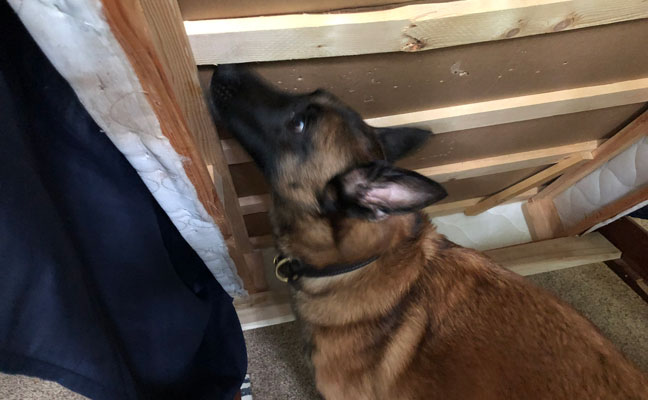
PHOTO: David Latimer
We haven’t yet, in this series on odor movement, discussed a training exercise to help your detector dog (and you) recognize the difference between a transient odor concentration and an odor source. It’s called the “point” and is demonstrated by the three dogs in the photos. The photos illustrate how the point can simplify and significantly shorten the visual search that should always follow a K9 alert to confirm the presence of the target substance.
I’ve taught arson, bomb, narcotics, bed bug and termite dogs how to identify source and how to reliably show their handlers exactly where that source can be found. To do that, I teach dogs what I call, the point. Performing the point means that dogs learn to hold their nose as near as they physically can to the specific area they’ve isolated as containing the odor source, similar to the way bird dogs perform the point to identify the location of quail or pheasants.
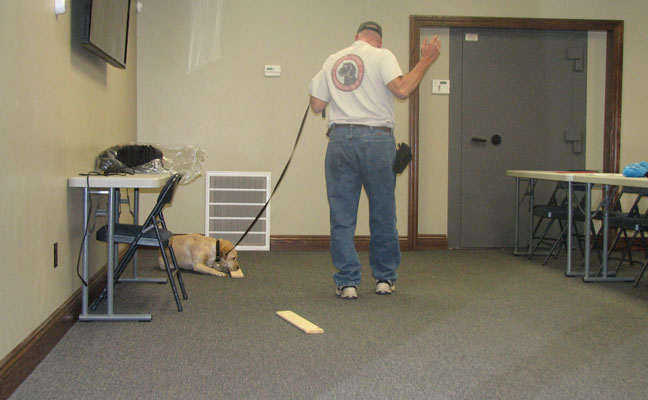
PHOTO: David Latimer
The “point” evolved during my days as an arson investigator. When I needed to take a fire debris sample. I needed to be sure the evidence I took came from the exact spot that the dog identified. It was crucial that I get this right because I needed a lab to determine if some ignitable liquid like gasoline was used to start or spread a fire. My case may not be prosecutable or at best very weak without such forensic evidence. I brought the point to my termite and bed bug dog training programs and found that it was an asset when it came time to visually confirm that the bugs were indeed exactly where the dog said they were.
In teaching the point, timing is crucial. I deliver a food reward by tossing the treat, just as I toss a toy to a toy rewarded dog. (I’m going to explain in much more detail in upcoming blogs why I do this rather than feed from my hand.) If you want your dog to learn to hold its nose at the odor source, you must reward when the dog is holding its nose at the source, not when it is looking at you or when it is looking or pointing its nose anywhere else. If you reward when the dog is looking at you, you’ll get a dog that looks at you for the reward. If you reward the dog when it is bobbing its head up and down in a clownish fashion, you’ll get a dog that repeatedly bobs its head up and down in a clownish fashion. You will get a repeat of whatever behavior you reward; dog training 101.

PHOTO: David Latimer
A dog that is taught the point, will quickly realize when it is not actually at source. It will abandon an alert to a transient odor concentration and re-engage the search until it finds the area where odor generation and its replenishment remains fairly constant and isn’t dispersed by air movement. This, of course, is where you are the most likely to find the subject of your search.

Brandon Price PHOTO: TRULY NOLEN
Truly Nolen Pest Control has promoted Brandon Price to IT Help Desk supervisor, based at the Tucson, Ariz., headquarters. Price joined the company in 2015 in an IT department support role. Prior to joining Truly Nolen, he spent two years working for a family-owned company, SunTap Water Systems, where he helped test and install reverse-osmosis and water softening systems.
“I am excited to take on more responsibilities and projects, while helping to implement changes to make the Help Desk the best it can be,” Price says. “My favorite thing about Truly Nolen is my co-workers, as I have built great relationships with many people who I have never met — all while helping to get a computer problem fixed.”
“Brandon has provided outstanding service in his previous roles, and I know he will bring that same level of professionalism to his new job and team,” says IT Director George Lawlor. “I know he will succeed in his new position, and I applaud him for his hard work and dedication.”
Founded in 1938, Truly Nolen of America is one of the largest family-owned pest control companies in the United States. It has more than 80 branch offices in Arizona, California, Florida, Nevada, New Mexico, Texas and Utah. The company also has independently owned and operated franchises in an ever-growing number of territories, including Kentucky, Georgia, New Jersey, Canada, Puerto Rico and more than 60 countries.

LOGO: Control Solutions Inc.
Find the perfect aerosol for any infestation: Pressurized Solutions — CSI’s all-new aerosol facility — includes specialized formulations manufactured under one roof. The lineup includes Stryker, Stryker 54, Spectre PS and Pivot Ultra. Learn more and request a sample today online.
Info.controlsolutionsinc.com/pressurized-solutions

PHOTO: iStock.com/shayneppl
In PMP’s March issue, Crawley McPherson presented a case of a “mysterious itch” — or delusions of parasitosis (DOP). This type of case is not uncommon. Unfortunately, many in the industry fail to handle these complaints professionally.
Read more: Fiction: Crawley and the mysterious itch
Often the customer begs for help and we, being compassionate, try to help them. A cardinal rule, however, is never treat unless you have identified a target pest.
If you provide any sort of treatment, you have confirmed in the customer’s mind that a biting pest is present. That leads you and the customer down a circular path that never resolves the problem.
Sometimes a treatment “alleviates the problem” on a temporary basis, which also “confirms” a pest is present. In such cases, the problem reoccurs quickly and you get a call to make another treatment. This can happen for a number of reasons. If you provide a space treatment, the aerosol droplets might “wash” the air of some contaminant and the problem disappears temporarily. Sometimes an aerosol treatment raises the relative humidity. Dry air can exacerbate skin problems. Such treatments give the customer false hope, and draws you deeper into a problem you cannot solve.
Lying to a customer also creates a problem. For instance, a homeowner wrote to me asking for a list of pest management professionals (PMPs) who would treat for “mold mites.” The man was told that these mites are very fast and difficult to capture. He also was told they breed so quickly that you can’t eliminate them.
A few phone calls later, I realized it was likely that one or more PMPs recognized he didn’t have a pest problem, so they made excuses to get out of the situation. This wasn’t helpful to the man, and certainly did not put the industry in a good light.
Several factors can contribute to mystery “bite” problems. In office environments, dry air, computer paper dust, cable coatings, static electricity in carpets and other environmental issues can cause bite-like skin reactions. Dry air, in particular, can exacerbate skin reactions to environmental contaminants.
If just one individual (typically in a family) is complaining, there are many medical issues that can cause bite-like reactions. Diabetes and varicose veins are common causes. Allergic reactions to detergents and fabric softeners also can cause such problems.
For example, I had a customer who was an allergist. She insisted her bites were from insects and demanded a treatment with an insecticide. We monitored for several weeks without finding any biting insect. I asked her whether she prescribed treatments for allergies when she didn’t know the cause. “Of course not,” she said. I then asked her why she expected me to perform a treatment when we didn’t know the cause. Later, she called and apologized after she determined a fabric softener caused her problem.
Some of these problems are caused by a psychosis — people imagine something is happening to them. When it happens to a housemate, a person can even become convinced it also is happening to him or her. These situations are rare, but they do occur.
1. Get a specimen for identification.
The easiest method is to place sticky traps in strategic spots. Inspect them within 24 hours; if a biting pest is present, you should have captured some. Common examples include bed bugs, bird mites, thrips, fleas, mosquitoes, spiders, lice, and pharaoh ants and certain other ant species. Usually, you will capture book lice (psocids) in sticky traps, but they don’t bite. Chiggers cause problems, but they live outdoors; you likely will not capture them indoors.
Use clear tape to press onto windowsills and other suspect surfaces to capture mites and other small specimens. Some customers will capture “stuff” from their skin and other surfaces. You will need a microscope of at least 30x power to examine such samples. A majority of these samples will contain bits of skin or other organic materials unrelated to bites. I’ve also spent hours looking at the contents of vacuums. This is usually non-productive, but sometimes necessary.
2. Ask a lot of questions.
When did the problem begin? Does it affect everyone? Does it come and go? The answers to these questions will help you determine whether it is really a pest problem or something else. Listen carefully. Sometimes the answer is right in front of you.
Sometimes it is a pest problem
Before you walk away, make sure you rule out even the smallest chance that a pest is involved. For example, I was asked to resolve a bite problem in a small office. There had been fleas, but a carpet treatment eliminated the problem. However, one person who sat at a desk continued to receive bites.
More monitors were placed. No fleas were found, except on the monitor on the desk of the person being bitten.
Further inspections found that a raccoon was nesting in the drop ceiling directly above this desk. Fleas were dropping from the ceiling. Those that reached the carpet were killed, but those that landed on the desk were not. Elimination of the raccoon and nesting materials resolved the problem.
3. If you can’t find a pest, you need to walk a fine line.
If no biting pest is found, then you should take no part in providing the solution. It is sometimes difficult to tell a customer you can’t help, but that is the professional action. Offering treatment will lead to other problems. However, the customer will be looking for guidance on how to proceed. You can help, but beware of becoming an expert in a field you know little about. I suggest the following tips:
⦁ If it is a group of affected people in a work environment, an environmental contaminant often is the cause. I usually suggest an industrial hygienist be hired to test the environment. Humidity will be tested and air samples collected to look for contaminants. If contaminants are found, the industrial hygienist and/or an engineer must determine the appropriate course of action. You are not in a position to make such judgment calls, but suggesting another professional to assist is helpful and appreciated by the customer.
⦁ If the problem is associated with one or few individuals, such as in a family unit, an allergen or medical issue may be present. If the problem occurs beneath clothing but not on exposed skin, detergents or fabric softeners may be causing the problem. If only exposed skin is affected, something in the environment may be causing the problem. I usually suggest that the person or persons visit their family doctor or an allergist. My experience with dermatologists is that many will diagnose the problem as a “bug bite.” You already know there are no biting bugs in the environment, so it must be something else. You shouldn’t make a diagnosis of the cause, but just giving the customer examples of problems and the appropriate professional to consult helps.
⦁ If you think it may be a psychosis problem (imaginary bugs), then recommending visiting the family doctor is the best advice. You can’t make this diagnosis, so don’t even suggest it. Examples include “they bore into my skin, they are too fast to capture” or “they are in my urine, I can see them but can’t trap one.” I had one such case, and medical professionals determined it was DOP. The family wanted a tent fumigation, even though we had signed documents stating no bugs were present and the fumigation would not eliminate imaginary bites. The state regulatory agency was advised, but OK’d the fumigation. The customer in question was “cured” by the fumigation. That was a weird situation that required the services of several specialists.
The bottom line is you are a PMP, so stick to what you know. If you can’t find a pest that bites, then suggest other professionals who might be able to help. Misinformation such as “mold mites breed too quickly” is neither helpful nor professional. But don’t get trapped into treating. You will regret it for a long time. There will be that rare customer who will insist on treatment and will not explore other causes. At that point, you need to walk away.

Dr. Joe DeMark, Field Scientist with Corteva Agriscience
Today’s technology includes trap detection systems, which provide real-time detection of rodent activity. A typical system alerts with text and/or email, identifying which rodent station was triggered, which allows for faster removal of the rodent.
Real-time information about rodent activity allows companies to determine where and when rodent activity took place, providing discovery of the “why.” This leads to corrective action, such as exclusion or client facility management changes, to avert future rodent problems.
There are additional service benefits. Monitoring in remote or difficult-to-access areas means these stations only need to be checked on alerts, limiting the constant need for technicians to climb ladders, use lifts or require client assistance to gain access to areas to manually check stations. In addition, in field trials, rodent decomposition before removal has been found to occur far less often overall using a trap detection system, compared to traditionally serviced sites — thus reducing odor and possible avoidance issues.
 If you dread making restroom stops during road trips you’re not alone. A new Harris poll commissioned by Cintas Corp. found that 56 percent of Americans have difficulty finding a clean... Read more
If you dread making restroom stops during road trips you’re not alone. A new Harris poll commissioned by Cintas Corp. found that 56 percent of Americans have difficulty finding a clean... Read more Brady has appointed a new management team for its operations in Arizona. Chrissy Sayre has been named regional general manager. In her new position, Sayre will lead Brady’s strategy and... Read more
Brady has appointed a new management team for its operations in Arizona. Chrissy Sayre has been named regional general manager. In her new position, Sayre will lead Brady’s strategy and... Read more
There’s so much to love about a restaurant; tantalizing aromas, delicious food and a luxurious ambience. Unfortunately, the presence of mold can also be high up on the list of what to expect from a restaurant – especially if certain precautions are not taken.
Between the ovens, stoves and storage equipment (read: water and steam) that is the very fabric of a restaurant kitchen, a high humidity environment is created that is prime real estate for mold.
Restaurant mold is particularly troubling – not only for the obvious reasons but also because keeping food quarantined in this environment is near impossible. As a business owner, you have a legal responsibility to the staff which are in your employ, and as a food establishment you must ensure that all hygiene standards are met.
Luckily, as per usual, we’re here to help you ensure your restaurant is mold-free at all times by following these top tips:
You really can’t take any chances when it comes to publicly serving food, so if you even have the sneakiest suspicion that your restaurant may have a mold problem, call in the experts immediately.
That’s because as well as being just horrible to look at, mold can cause a whole host of health problems, from skin and eye irritation to asthma, bronchitis and even cancer – if exposed long enough. Forget costing your restaurant’s reputation with hefty fines or a complete shutdown; a neglected mold problem can seriously endanger the lives of both your staff and customers.
Bon appetite!

Dillan Drennan receives his scholarship. PHOTO: BOG PEST CONTROL
Harwood, Md.-based BOG Pest Control has selected Southern High School graduate Dillan Drennan as its 2018 scholarship winner. The BOG Pest Control merit-based scholarship is awarded to one student annually pursuing a degree in chemistry, chemical engineering, biology, environmental studies or a related field.
“At BOG Pest Control, we are dedicated to promoting the well-being of our customers and the community we live in,” notes BOG co-owner Brad Leahy. “Whether it’s implementing organic-based and Bay-friendly pest control techniques and products, or investing in the life of someone through a scholarship, we are proud to make an impact.“
Drennan has had a successful high school career, earning a 3.78 GPA while playing three sports, participating in the Model United Nations, and holding a part-time job.
After watching his older brother become an environmental scientist, Drennan developed a passion for the environment, as well. Though Drennan will be majoring in accounting/finance, he plans to work for a company that positively affects the environment. He says he hopes to leave a lasting “green” effect on the company he ends up working for in the future.

Photo: Neogen
SureKill Dia-Py Insecticide Dust is diatomaceous earth (DE) dust impregnated with pyrethrin and piperonyl butoxide (PBO) to provide quick knockdown and kill with a long-lasting residual. The dust controls most crawling insects, including bed bugs when used as a crack-and-crevice treatment, in food-handling facilities, stored products, residential, commercial, agricultural and many other sites as listed on the label.
AnimalSafety.Neogen.com/en/surekill-dia-py-insecticide-dust

A first in-star bed bug doesn’t always have a whole lot of hiding options, so a cast skin of an older relative will do in a pinch. PHOTO: Mark Vanderwerp, BCE
⦁ Freshly hatched bed bugs can hide inside cast skins.
⦁ Vacuuming all evidence, as well as live bugs, is worth the effort.
Bed bugs (Cimex lectularius) can’t fly, but they do have some surprising tricks. A common refuge for first-instar bed bugs is inside the cast skins of larger bed bugs. If you don’t think so, get a handful of exuvia from an active infestation and start checking.
I learned this during a Take Your Daughter to Work Day. I was entertaining several bright young girls by letting them examine cast skins under a microscope when one of them proclaimed, “I see a live one!”
“No, they’re not alive,” I responded, but she insisted. Upon examination, I realized she was right. From inside a cast skin, a tiny bed bug had emerged to amuse the children and confound the entomologist.
I put the young one to the sword for its ambition (the bug, not the daughter). Back then, a live bed bug loose in your office could put you off your feed. Now,
I figure it’s all part of the job.
We’ve all seen cast skins fly around, but have we considered that some of them might be carrying a tiny refugee? This just reinforces the value of vacuuming before a treatment. When you increase the number of bugs that survive the application, you up the odds for a rebound. Heat treatments should be effective against these little stowaways, but it’s even better to suck them all up at the outset and be done with it.
A single, first-instar nymph cannot start an infestation by itself, but there’s almost always more than one. And if you consider those locations where the population has exploded, you can easily imagine how many chances could be blowin’ in the wind.
This has caused a world of confusion for scent detection teams, who have to use dead bed bugs and cast skins to train the dogs not to alert on old evidence. A vial of old cast skins may be hiding a live bug or two inside. The wise handlers heat their dead bug evidence just to make sure no one is playing possum. During a search, a dog will often alert, and the subsequent search turns up old evidence, but no live bugs. This behavior might explain a lot of them.
If you had to “unzip” all those “sleeping bags” and look inside, you might be there forever.

Dr. Chris Keefer, Technical Services Representative, Syngenta Professional Pest Management
Before treating, it is imperative to distinguish among the three common commensal rodents: the house mouse (Mus musculus), roof rat (Rattus rattus) and Norway rat (R. norvegicus). First, inspection is critical. Identify conducive conditions to help you implement non-chemical controls like sanitation, exclusion and mechanical devices.
Additionally, you must understand behavior and population dynamics of the species you are targeting. Try different lures on mechanical devices like sweets, proteins and starches to determine the target population’s diet. If bait shyness occurs when using rodenticides in bait stations, pre-bait the station with the preferred diet before using the rodenticide.
 4M Building Solutions, a CIMS-GB-certified organization, was recently awarded janitorial services contracts with two firms. 4M will provide janitorial services to healthcare support... Read more
4M Building Solutions, a CIMS-GB-certified organization, was recently awarded janitorial services contracts with two firms. 4M will provide janitorial services to healthcare support... Read more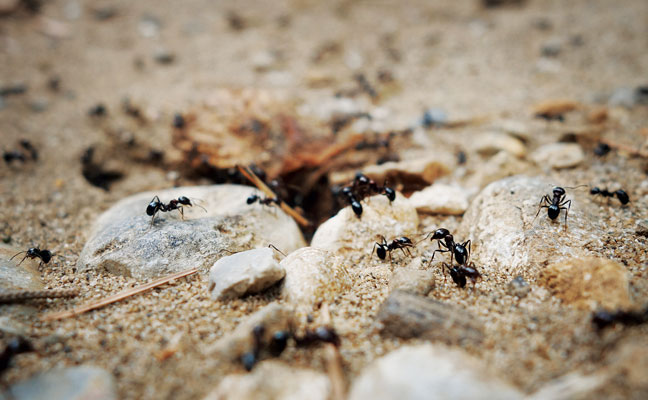
PHOTO: iStock.com/FLORY
No matter how long you’ve been a PMP, chances are you’ve experienced a callback (or two) on an ant management job. You can develop a strategy, though, that will help reduce the number of callbacks, ensure customer satisfaction and even boost revenue. Success depends on finding the nest. Here are some suggestions for locating nests of five different ant species.
Odorous house ants (Tapinoma sessile): Nests likely will be near homes outdoors in soil and under mulch, logs and rocks, or in cracks. They may also be found in the walls and floors of a structure.
Pavement ants (Tetramorium caespitum): Nests typically are found outdoors in the soil under and next to cement slabs, sidewalks, patios and driveways. But they can also be indoors under foundations and inside hollow walls.

PHOTO: iStock.com/BanksPhotos
Carpenter ants (Camponotus spp.): Look for nests outdoors where wood, like tree stumps and plants, is damp or moldy, and indoors where wet and damaged wood allow them to enter.
Little black ants (Monomorium minimum): Search
for nests outdoors under rocks, bricks and lumber. Search indoors behind facades and in woodwork, decaying wood and wall voids.
Argentine ants (Linepithema humile): Nests usually are shallow and found outdoors under plants, stones and boards, or along sidewalks.
SOURCE: NATIONAL PEST MANAGEMENT ASSOCIATION
Read more: 5 ways to conquer ant callbacks
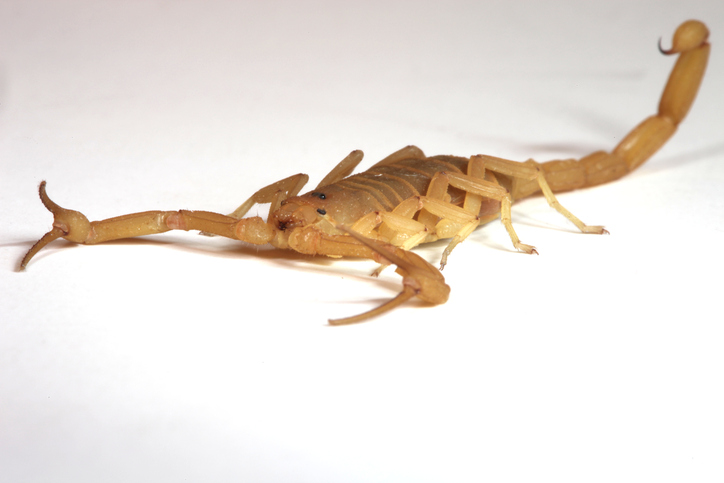
Arizona bark scorpion (PHOTO: iStock.com/Srabin)
For customers dealing with threatening scorpions, a pest management company that can provide reliable scorpion control is a must-have. Providing this service offers a chance to keep these pests at bay and build long-term relationships with thankful customers.
To run a long-term, sustainable scorpion management program, it is important to consider the urban ecosystem and make it less hospitable for scorpions. This can be accomplished by a sound integrated pest management program, which should include:
The third step is typically the most overlooked part of this process. A deliberate approach to reducing scorpion prey can be easy, highly effective and an opportunity to make a long-term impact on scorpions where they breed outdoors.
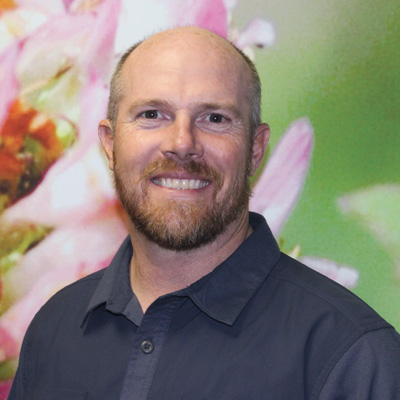
Dr. Eric Paysen, Technical Services Manager, Syngenta Professional Pest Management
Scorpions are predators who hunt for their prey at night to avoid the heat of the day. Likewise, many of the prey arthropods that scorpions eat are overlooked during daytime inspections. Common scorpion prey in urban settings include crickets, cockroaches and earwigs. Each of these is a pest in its own right when entering structures and, when their numbers are left unchecked, can lead to population explosions in top predators like scorpions.
While well-placed, residual liquid applications can have an impact on scorpions, granular baits can also be a useful tool for scorpion prey control. An appropriate granular bait application takes very little time, as it is usually a ready-to-use product with no mixing required. Using both in a one-two punch — reducing scorpions and their prey — can increase your odds of success.
I suggest applying granular bait around the building foundation with a spreader, creating a treated zone. You can also make applications to other areas in the landscaping where prey may hide, such as piles of river rock or flower beds.
After an initial application, it is not uncommon to find dead crickets, cockroaches and earwigs littering sidewalks and other areas adjacent to treated harborages. Judicious applications in the spring and summer will have the most impact, since these prey insects typically multiply with moisture and warm temperatures.
Thinking holistically about scorpion control can help make your treatment stronger and your customers happier.

Ed Dolshun, Technical Director and VP of Business Development, AP&G
It is not uncommon for numbers of captured rodents to drop after a successful initial trapping. Increase your chances for success by changing up your trapping sets, and moving traps to different locations within the account. It can also be helpful to move around other things that the remaining rodents have become accustomed to navigating around — like small furniture, boxes or other household items.
Doing so will force the rodents to re-explore their environment, and become more likely to encounter your newly positioned traps.
from Pest Management Professional http://www.mypmp.net/2018/08/29/relocate-traps-for-more-successful-rodent-control/
Sacramento CA
 ISSA is pleased to announce the following individuals have been elected to serve on the 2019 ISSA Board of Directors, which will be led by incoming ISSA President Paul Goldin of Avmor Ltd. Vice... Read more
ISSA is pleased to announce the following individuals have been elected to serve on the 2019 ISSA Board of Directors, which will be led by incoming ISSA President Paul Goldin of Avmor Ltd. Vice... Read more